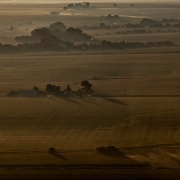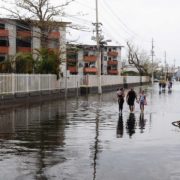Peter Gleick and Phaedra Ellis-Lamkins: Jobs and Water for America
Every year, our old water infrastructure spills 860 million gallons of untreated waste into America’s waterways, including raw or partially treated sewage, bacteria, parasites, synthetic hormones, pharmaceuticals, and agricultural wastes.
We have old leaky pipes and outdated water-treatment systems. Our irrigation systems are inefficient and our home water-using appliances outmoded. People increasingly fear our tap water and spend billions for bottled water in the mistaken belief it is somehow better.
This is inexcusable for a developed nation, or frankly, any nation, and it is preventable. Even better, preventing it can create jobs: good jobs that pay well. By recent estimates, just fixing our stormwater and wastewater systems would generate nearly 1.9 million jobs – one for every seven people who is out of work.
The United States has a remarkable water system that provides safe drinking water, sewage collection and treatment, stormwater and floodwater management, and more. Our initial investments in water purification and treatment systems eliminated the water-related diseases like cholera and dysentery that just a century ago ravaged our cities and killed our children, and still do in developing countries. Our construction of dams and reservoirs, often with taxpayer money, powered our factories during World War II, provided flood and drought protection, and helped the nation vastly expand agricultural production.
But our investments in water are no longer adequate, and the great water systems of the U.S. are in decay. Most of these systems, paid for by local users, are underfunded and need new investments in maintenance, expansion, and upgrading. Federal water systems are under threat because of the blind, anti-tax mentality that is depriving all sorts of critical national infrastructure of investments we need to remain a strong and modern nation. The American Society of Civil Engineers 2009 Report Card for America’s Infrastructure rated both the nation’s drinking water and wastewater infrastructure a D-, the lowest grades given to any public infrastructure.
On the international stage, the World Economic Forum will soon downgrade America’s overall infrastructure ranking to 16th in the world, from 6th just a few years ago. The USGS estimates that the country loses six billion gallons of clean drinking water each day, or 14% of all that is used, through leaky pipes in need of repair. The EPA reports millions of cases of illness caused by contact with waters contaminated by sanitary sewer overflows because we don’t have enough modern treatment plants. And we face new threats from industrial contaminants that are increasingly found in drinking water systems but not removed by antiquated treatment plants, widespread contamination of waterways by agricultural chemicals, and the impacts of climate change on water availability and quality.
Our first round of environmental laws, passed by Republican and Democratic bipartisanship in the late 1960s and early 1970s, helped save the Great Lakes from destruction, improved human health nationwide, and protected local rivers, streams, and lakes from uncontrolled pollution. But those national laws are desperately in need of updating.
The potential to add quality jobs and to fix our water problems at the same time is enormous. Meeting the need for over $180 billion in improved stormwater systems and pipe repair documented in the EPA’s 2008 Clean Water Needs Survey will produce healthier communities, reduce water pollution, and directly generate nearly1.9 million jobs – with an additional 800 thousand jobs from increased economic activity in related sectors. Our organizations – working with the Economic Policy Institute and American Rivers, with generous funding from the Rockefeller Foundation – yesterday released Water Works: Rebuilding Infrastructure, Creating Jobs, Greening the Environment, a comprehensive look at what upgrading our water systems would actually look like. We stand to add over a quarter of a trillion dollars to the GDP, and create a diverse array of jobs: from appliance manufacturing to home construction to major engineering projects updating water infrastructure. Many of these jobs provide career pathways and good wages, while promoting regional economic development.
There is no better time for smart investment in sustainable, modern water infrastructure.
- Water infrastructure investments would create jobs now, when they are most needed.
- The cost of financing this investment is at historic lows.
- Infrastructure investments are more effective at creating jobs than payroll tax holidays, across-the-board tax cuts, and temporary business tax cuts.
- Water investments, if done right, save energy, increase land values and recreational spaces, improve health, restore local environments, increase resilience to climate variability and change, including flooding and droughts, and can be designed to reduce disparate environmental impacts on poor communities.
Meeting water challenges — building a resilient water future — will require both local and national efforts. The U.S. must strive to increase water efficiency, restore waterways and groundwater, repair and upgrade decaying infrastructure, decrease contaminated stormwater runoff, and more. These efforts can help ensure the U.S. can clean its waterways, reduce pollution, promote economic growth, and provide safe drinking water to all. In other words – this doesn’t all have to happen out of Washington.
And it’s a good thing it doesn’t. Congress’ response to addressing infrastructure problems is now simply two things: cut taxes and reduce investments. According to the Congressional Budget Office (CBO), total public investment in water infrastructure has fallen by over a third as a share of the economy since peak levels of investment in 1975. It is time for a renewed commitment to invest in the health of our communities through efforts that improve water quality, reduce wasteful water uses, and build modern systems. As cities recognize the immense value of green infrastructure in promoting clean water and economic development, we have an opportunity to ensure that all investments in our water infrastructure meet high road standards that create accessible, family-supporting jobs, are financed by stable and fair means, and maximize environmental gain.
Americans need safe water for all, efficient agriculture, modern and comprehensive water treatment systems, healthy rivers and lakes, and a 21stcentury water infrastructure. And we need jobs. The great thing is that we can have all of these things – if our policymakers have the will to stand up for clean water.
Dr. Peter Gleick, President of the Pacific Institute in Oakland, is a regular Forbes blogger. His co-author on this piece, Phaedra Ellis-Lamkins, is CEO of Green For All, a national organization dedicated to building an inclusive green economy strong enough to lift people out of poverty.
Originally published by Forbes on October 5, 2011.








Hey “Peter”!
Why don’t you just go give yourself a “job”.
http://www.dalailama.com/webcasts/post/210-ecology-ethics-and-interdependence—mind-and-life-xxiii
You are a pervert and so are your fans!